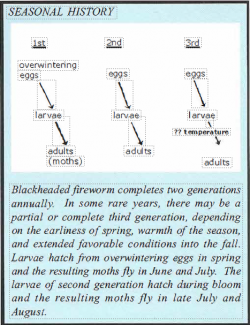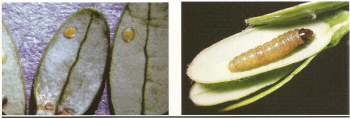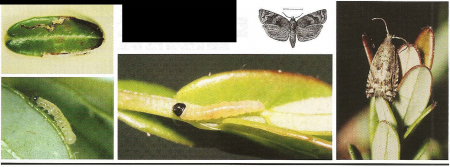Black-headed Fireworm (2005)
BLACK-HEADED FIREWORM
(Rhopobota naevana Hubner)
Lepidoptera: Tortricidae
University of Massachusetts/Amherst, Cranberry Station Martha M. Sylvia and Anne L. Averill
On cranberry in North America, there are several different species in the family of leafroller moths (Tortricidae) that are called 'fireworms,' three of which are economically important. Spotted fireworm, Choristoneura parallela (Robinson), occurs as a severe problem in New Jersey. Yellowheaded fireworm, Ac/eris minuta Robinson, appears sporadically in Massachusetts. Blackheaded fireworm, Rhopobota naevana (Hubner) is a key problem throughout North America. The larvae of these three 'fireworms' damage the vines by skeletonizing the leaves, often so severely that areas of the cranberry bed turn brown and appear burned. The larvae wriggle vigorously when disturbed and use silk to construct protected feeding sites by webbing together cranberry uprights.
Blackheaded fireworm (BHFW) is a major pest throughout N orthAmerican cranberry growing regions. Historically, this species was chief among the damaging insects in Massachusetts. In the second half of the 20th century, BHFW lost its key pest status in Massachusetts and was found only in high numbers in wild and unmanaged beds. It occurred very sporadically on commercial beds. Lately however, we have seen a remarkable resurgence ofBHFW in Massachusetts, and it bas again become a serious problem for many growers.
SEASONAL HISTORY
The egg stage overwinters. Spring egg hatch normally begins close to the time that the cranberry plant breaks dormancy, about the middle of May, but it may be earlier depending on bog conditions. The hatching period of the overwintered eggs in the spring may last for up to 6 weeks on heavily vined bogs or in cool weather.
In the spring, newly hatched larvae burrow into a cranberry leaf or mine into the unopened terminal buds as they swell. They strongly prefer the growing, new leaves over last year's growth. Larval development within old leaves is very slow when compared to new leaves. On new growth, the larva silks together two or more leaves in the tip area of the upright and feeds within. As the season progresses, older caterpillars web a few uprights together, creating a tent. According to Maurice et al. (2000), one larva may construct up to 5-6 tents during the course of its development. Development from egg hatch to the end of the pupal period may be completed in 4-5 weeks for this first generation.
The first generation of moths emerges, mates, and lays eggs in June and July. In British Columbia and Wisconsin, eggs laid by the first generation females began hatching within 2-7 days and the majority of eggs hatched by 6-15 days after they were laid (Cockfield et al. 1994 ). However, a portion ( 5-10%) enter diapause and hatch is delayed until the following spring (Fitzpatrick and Troubridge 1993). Development from egg hatch to the end of the pupal period may be completed in around 3-4 weeks for the second generation (Averill and Sylvia 1998). In controlled studies at constant 20° C, Fitzpatrick and Troubridge ( 1993) found that the durations of first generation pupal and adult stages were ca. 10 and 7 days, respectively; the durations of second generation pupal and adult stages were longer, ca. 13 and 10 days, respectively.
Females of both first and second generations lay about 70-80 eggs (Fitzpatrick and Troubridge 1993). Firstgeneration moths lay eggs toward the tip of the upright while second-generation females tend to lay eggs lower in the vine canopy, but still utilizing the current season's growth. Females are able to begin laying eggs within a day after emergence. Fitzpatrick and Troubridge ( 1993) determined that for Pacific coast populations, first generation females laid 75-80% of eggs on the day after mating. Second generation females laid approximately 50% of their eggs on the day following mating and then gradually laid the remainder in the 3-4 following days.
(*Clockwise from left: Damage from tiny larva acting as a leafminer, tiny larva, small larva, and the adult moth.*)
INSECT DESCRIPTION
Egg: Eggs are laid singly on the back of leaves. They are flat, yellow disks (0.8 mm, 1/32") and become very dark just prior to hatching. The larva's black head can be seen inside the egg in the day or two before it hatches. Several eggs may be found on one leaf.
Eggs are laid singly on the underside of leaves.
Larva: The larva has a distinct shiny black head and the body is a greenish, greenish-yellowish, or grayish color. Mature larvae are only 7-9 mm (1/3-1/2") long and complete larval development in 2.5 - 5 weeks.
Other than newly-hatched Sparganothis fruitworm larvae (which lose the black head at the first molt), no other pest larva has a jet-black head capsule; thus, the black head can serve as a diagnostic trait to differentiate BHFW from the many other types of larvae on the Massachusetts bog.
Pupa: Pupae are light brown or yellowish brown and are 6-7 mm (1/4") long and are found silked in the tent of uprights or within the trash layer below the vines.
Adult: The moth is small, ca. 9-10 mm (3/8") across the expanded wings. The forewings are marked with gray-brown and silver-gray bands. They fly in the daytime through dusk. According to Maurice et al. (2000), most mating occurs in late afternoon and everung.

SCOUTING
Scouting is difficult, particularly for small larvae. However, it is absolutely critical to management since these young larvae are most susceptible to chemical treatments.
Sweep net sampling has been recommended for many years by the Massachusetts IPM program. Treatment is now advised if an average of 2 caterpillars is found in 25 sweeps of a sweep net. Based on observations in Wisconsin, when larvae are small, this sampling approach can be risky because of the very poor relationship between the actual infestation level of young caterpillars on a bed and the number picked up in a sweep net. Further, the infestation most often is patchy: "hot spots" of fireworm are common, particularly along edges. Sometimes hot spots occur where vines are overgrown, where leaf trash has accumulated, orwhere winter flooding was truncated. As a result, spot treatment is desirable here.
Visual sampling: Because there is a poor relationship between the number of small larvae picked up while sweeping and the actual infestation, in British Columbia and Wisconsin, where BHFW has caused serious damage for years, visual sampling is recommended. This is a more effective means to detect an infestation of small larvae. Monitoring in Massachusetts should begin as soon as larvae begin to hatch, which in the earliest years will be the first week of May, and typically is near mid-May. The earliest activity should be sought out in the wam1er bog edges and known "hot spots" by inspecting buds and leaves for mining, webbing, and brown pellets of excrement (frass). According to Maurice et al. (2000), 1-2 weeks after the earliest larvae are first seen, more extensive monitoring can be done by 'visual sweeps.' This involves crouching down to closely exan1ine areas of about 2 ft2. Repetition of ten 'visual sweeps' is recommended per acre.

When the caterpillars are half-grown or larger, they are more readily picked up in a sweep net and the munbers reflect the actual infestation level-but at this point, larval size may be beyond the point where the most effective management can be realized.
(*Left to right: Eggs are laid singly on the underside of leaves; A full size ready-to-pupate larva is still considerably smaller than a cranberry leaf.*)
Pheromone traps can be used to monitor the June/ July flight of male moths. A substrate, such as a rubber septum, is treated v.rith synthetic female sex pheromone and placed inside a trap. Attracted males are caught on sticky surfaces inside the trap. Different sticky traps ( see photos below) may be used. The same type should be used throught the entire moth flight. Under conditions of heavy infestation, the larger trap type (wing trap) should be used since the surface area of the smaller trap (Pherocon II) may become saturated with moth bodies, throwing off accurate counts.
Based on work in Wisconsin, some rules of thumb were found for estimating egglaying following the point in time when the the first few moths were caught in a pheromone trap (= 'biofix'). They found that oviposition began '7-12 days after biofix, peak flight of males occurred 14-22 days after biofix, and that flight was completed 35-42 days after biofix (Cockfield et al, 1994a). Counts ofmoths may allow accurate timing of treatments for 2nd generation, and among-year catches can give an indication of population levels. The traps should be put out ca. June I and cleaned and checked regularly. In the past, it was advised to check the traps weekly; however, if one aims to pinpoint biofix, the traps should be checked every 1-2 days until the biofix is established. Pheromone traps are key in timing both chemical sprays and mating disruption (see page 5).
INJURY: The foliage turns brown over time as a result of larval feeding. Infestations may occur at the same bog site in successive years. The second generation of females lays egg from June through bloom. This timing makes management of the larvae difficult, since some pollinators are usually present. Fruit damage is usually limited to surface feeding and thus, is different from cranberry fruitworm (Acrobasis vaccinii) where the larvae feed entirely within the fruit. This generation may reduce the crop for the next year because the feeding on the tips of the upright results in a failure to fonn normal fruit buds.
| Stage | Timing | Location | How to Sample |
|---|---|---|---|
|
Eggs, overwintering
Eggs, summer |
September - May
July |
Underside of leaf
Underside of leaf |
In early spring, at each of 5 locations on each bed, collect 20 uprights and examine leaf underside for eggs |
|
Larvae, spring
Larvae, summer |
May
end June - August |
Small larvae may burrow within leaf or developing buds; larger larvae are sandwiched between leaves or within tent of uprights
|
Small larvae: Use visual sampling where you search for larvae in a 2ft^2 area. Complete 10 squares/A.
Mid-size to large larvae: Complete 1 sweep set (drag the net across the vines, in 180Y arc, 25 times) per acre. |
|
Adults, 1st flight
Adults, 2nd flight |
June-July
August - September |
Flying amoung vines, particularly at dusk | Pheromone traps |
|
Pupae, spring
Pupae, summer |
June
August |
Inside silk case between leaves or in trash layer of bog |
MANAGEMENT
Ecological management:
Sanding: Regular and uniform sanding regimes and complete trash flows discourage outbreaks. It is particularly hard to manage populations in heavy, rank vines. Here, hatch may be very asynchronous, resulting in an extended period of moth flight and egglaying. Further, in rank vines, one is even less likely to pick up larvae during sweeping. Care should be taken when replanting and one is importing vine from possibly infested beds.
Flooding: A short spring re-flood is possible and must be carried out by monitoring egg hatch. If egg hatch has not occurred, the flood treatment is negated. Following egg hatch, floods will reduce the number of larvae, but likely not eliminate all larvae.
In Massachusetts, the traditional BHFW flood was advised for 24-48 hours in mid-May when harm to the cranberry vine (plants have not substantially broken dormancy) is minimized. The success of such an approach was evaluated by Cockfield and Mahr (1992), who reported field trials in Wisconsin. At three sites, 24-50 hour floods while the vines were still dormant in the second week of May, showed significant reductions in BHFW larvae.
Flooding was also studied in the lab by Cockfield and Mahr (l 992). They found that larval mortality was very high after 2 days under low dissolved oxygen levels. However, under conditions of high dissolved oxygen, the larvae could survive for days; their silken shelters likely trapped air when the vines were submerged.
It is clear that several factors must be considered for an effective flood: known egg hatch, plant development, water temperature, and water dissolved oxygen (Cockfield and Mahr 1992).
Biological control:
In a review, Mahr (1999) noted that in several studies of BHFW, a very low level of larval parasitism was found. On the other hand, he asserted that very tiny wasps, Trichogramma sp., that parasitize blackheaded fireworm eggs may play an important role. Henderson et al. (2002) found high levels of Trichogramma parasitism in British Columbia. Two species of Trichogramma, both native to British Columbia, were reared from blackheaded fireworm eggs. Mass production has been successful and protocols for release have been addressed (Henderson et al. 2002). One species is commercially available for management of the summer generation. Check with the Cranberry Station for contact information and availability.
Mating disruption:
The use of synthetic sex attractants (synthetic sex pheromone) to disrupt mating has been investigated in British Columbia and Wisconsin. This activity blocks the ability of males to find females for mating, and, as a result, there is a reduction in the number of fertile eggs laid. Different delivery systems for the sex pheromone have been evaluated, but commercial availability of the different systems is in flux. Check with the Cranberry Station for the most current contact information and availability.
Chemical control:
For best results with the insect growth regulators (Confirm, Intrepid), keep in mind that, based on trap catch data, applications of these newer chemicals follow a different schedule in comparison to conventional insecticides ( e.g., Diazinon). It is recommended that Confirm or Intrepid be applied around the third week after the onset of moth flight while Diazinon be applied 10 days after peak flight. Consult the current Cranberry Chart Book for more extensive infonnation on chemical management.
Literature
Averill, A.L. and M.M. Sylvia. 1998. Cranberry Insects of the Northeast. UMass Extension Publication.
Cockfield, S.D. and D.L. Mahr. 1992. Flooding cranberry beds to control blackheaded fireworm (Lepidoptera: Tortricidae). J.
Econ. Entomol. 85: 2383-2388.
Cockfield, S.D., S.M. Fitzpatrick, K.V. Giles, and D.L. Mahr. 1994a. Hatch ofblackheaded fireworm (Lepidoptera: Tortricidae)
eggs and prediction with temperature-driven models. Environ. Entomol. 23: l 0 1-107.
Cockfield, S.D., S.M. Fitzpatrick, K. Patten, D. Henderson, T. Dittl,A. Poole, C. Shanks, and D.L. Mahr. 1994b. Modeling of blackheaded fireworm (Lepidoptera: Tortricidae) oviposition and pheromone-trap catches. J. Econ. Entomol. 87: 787-792.
Fitzpatrick, S.M. and J.T. Troubridge. 1993. Fecundity, number of diapause eggs, and egg size of successive generations of the blackheaded fireworm (Lepidoptera: Tortricidae) on cranberries. Environ. Entomol. 22: 818-823.
Henderson, D.E., S. Y. Li and R. Prasad. 2002. Rhopobota naevana (Hubner) Black headed Fireworm (Lepidoptera: Tortricidae) pp. 242-246 in Biological Control Programmes in Canada, 1981-2000. CABJ Publishing, NY, NY
Mahr, D.L. 1999. Biological control in a high-value native crop: Status, opportunities, and constraints in cranberry. pp. 64-90 In: Biological control of native or indigenous pests: challenges, constraints, and potential. Ent. Soc. Amer.
Maurice, C., C. Bedard, S.M. Fitzpatrick, J. Troubridge, and D. Henderson. 2000. Integrated Pest Management for Cranberries in Wesern Canada-A Guide for Identification, Monitoring and Control for Key Pests and Diseases in Cultivated Cranbeny Fields in Western Canada. Technical Report 163 Pacific Agri-Food Research Centre-Agassiz.
Shan.ks, C.H., L.J. Dapsis and L.M. McDonough. 1990. Monitoring blackheaded fireworm (Lepidoptera: Tortricidae) populations in cranberry bogs with sex pheromone traps. In:Monitoring and Integrated Management of Arthropod Pests of Small Fruit Crops. N.J. Bostanian, L.T. Wilson, and T.J. Dennehy, Eds. pp. 131-139.
Cranbeny Station
University of Massachusetts Amherst
P.O. Box 569, East Wareham, MA 02538
508-295-2212 www.wnass.edu/cranberry
April 2005. A product of the Cranberry Station, College of Natural Resources and the Environment, University of Massachusetts Amherst. UMass Extension.
United States Department of Agriculture cooperation. UMass Extension provides equal opportunities in programs and employment.
Martha M. Sylvia is the technician in the Entomology lab at the Cranbeny Station in East Wareham, MA. Anne L.Averill is a professor in the Plant, Soil, and Insect Sciences Department at the University of Massachusetts in Amherst, MA.

